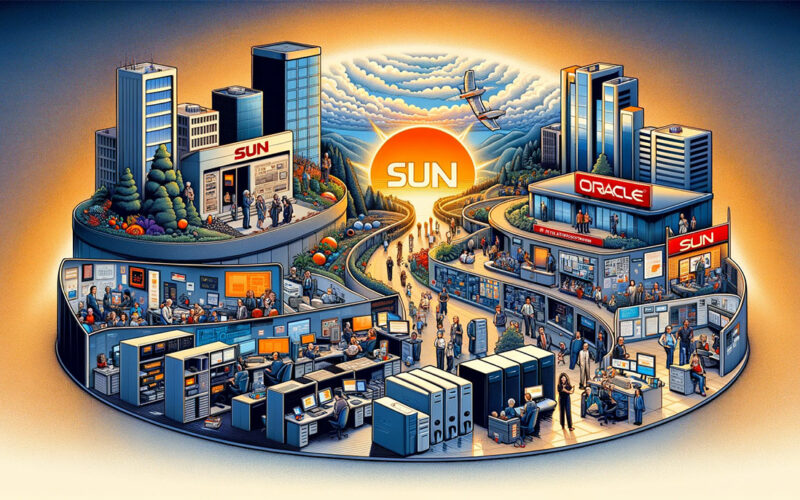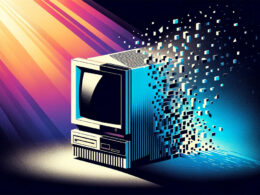Tech’s Sunset: What Happened to Sun Microsystems?

So, you’ve probably heard the name ‘Sun Microsystems’ tossed around, especially when tech geeks get nostalgic about the good old days. They were like the cool kids on the block in Silicon Valley.
Imagine a world where computers were these huge, clunky things that most people couldn’t fathom having in their homes. Sun changed the game.
They made machines that were not only powerful but also a bit more ‘I could actually fit this in my house’ kind of vibe. They were wizards with hardware, turning out systems that could handle some serious number-crunching.
But what happened to Sun Microsystems, right? That’s the twisty tale we’re diving into. They went from being on top of the world to, well, not. Think of them as a shooting star that lit up the tech industry—super bright, super fast, and then, poof. It’s a story of innovation, missteps, and a whole lot of tech drama.
Talking about significance, these folks were the Gandalfs of the tech world. They didn’t just build computers; they shaped the landscape of the tech industry.
Their software, their ideas about network computing—man, they were ahead of their time. But just like that cryptic wizard, they had their falls. So, when you’re scrolling on your smartphone, remember that a lot of today’s tech magic started with companies like Sun.
The Rise of Sun Microsystems

Founding and Early Innovations
Creation of Powerful Workstations
Back in the day, when the word ‘workstation’ made people think of a desk, Sun was busy crafting a whole new beast. These machines were monsters, in a good way.
They gave scientists, engineers, and anyone crunching big data the muscle they needed. And it wasn’t just muscle; these workstations had brains, thanks to the influence of Xerox Park Research Laboratory.
Influence of Xerox Park Research Laboratory
You know, that place where the future was being brewed in the 70s and 80s? Xerox PARC, yeah, that’s the one.
They had ideas about UI and tech that were so futuristic, people probably thought they were using alien tech.
Sun Microsystems soaked up all that innovation like a sponge and squeezed out some of the smartest tech in the market.
Revolutionizing the Workstation Market
The Impact of Sun Workstations
What happened to Sun Microsystems’ workstations, you ask?
They became the dream. Universities and businesses got hooked because, suddenly, the power to do more was right there on the desk.
It was like going from a horse-drawn cart to a sports car overnight.
Competition with Apollo Computer
And it wasn’t a solo race. Apollo Computer was in the next lane, foot on the gas just as hard. The rivalry? Intense.
Every release from either camp was like a new round in the heavyweight championship of computing.
Software Contributions and Partnerships
Development of Java
Here comes the plot twist in what happened to Sun Microsystems—Java. Yeah, the programming language that’s practically everywhere now?
That was their baby. They didn’t just make a new language; they practically gave birth to a new era in cross-platform software.
Alliance with Motorola
Partnerships are everything, right? Sun knew this. Teaming up with Motorola was like getting a supercharger for their hardware.
They were in it to win it, pushing the envelope of what was possible, and setting the stage for what was to come in the tech saga.
Strategic Missteps
Failure to Embrace x86 Processors
Okay, let’s chat about a big oops moment in the saga. Remember when everyone was geeking out over those x86 processors? They were like the new hotness in the chip world, right?
But our friends at Sun, they kinda missed that party. They clung to their SPARC processors like a lifeline.
Now, those chips were no slouch, but the winds were changing, and they didn’t catch the breeze. That’s a big part of what happened to Sun Microsystems—they zigged when the world zagged towards x86.
Missed Opportunities in Java Tools
Late Entry into the Market
Java, the brainchild of Sun, was like this golden egg, but oh boy, did things get scrambled. They were late to their own party.
The market was crying out for tools to make the most of Java, and Sun? They hit snooze.
By the time they showed up with their Java development history-worthy tools, the room was already packed with others.
Developers had moved on, cozying up to what was already there, and Sun was left knocking at the door.
Ineffective Acquisitions and Investments
You know how in those big blockbuster movies, the hero sometimes makes a move that has you shouting, “No, what are you doing?!” That was Sun.
Their shopping spree on tech companies and software didn’t quite pan out.
These moves were supposed to be their ticket to the big leagues of software, but they ended up more like a collection of puzzle pieces from different boxes. They just didn’t fit together.
Overreliance on Hardware Culture
Neglect of Software Initiatives
Software was the rocket ship to the future, but Sun was still building hot rods. Their hardware rocked, but that overreliance? It was like wearing blinders.
The neglect of software initiatives meant they were missing out on a whole universe of possibilities.
This is key in unraveling what happened to Sun Microsystems—their leadership’s hardware bias had them sticking to their guns even when everyone else was playing laser tag.
Market Challenges and Competition
Impact of the Dot-com Bust
When the dot-com bubble went ‘pop’, it was like a bad hangover after the best party ever. Everyone was reeling, and Sun Microsystems felt it big time.
Their financial issues piled up like unread emails. This was a time when their workstation market share was supposed to shield them, but even that armor had chinks.
Competition from Emerging Tech Giants
Rise of Microsoft and Google
Now, onto the heavyweights—Microsoft and Google. These guys were like the schoolyard champs of tech. Microsoft had everyone’s desktops, and Google?
Well, they had everything else. Sun was playing catch-up in a race where these titans were setting a blistering pace. It was a tech industry lesson, loud and clear—adapt or get left behind.
IBM’s Eclipse Workbench
Then there was IBM, cool as ever with their Eclipse Workbench. It was like they brought a gun to a knife fight.
This platform was giving developers the ‘all you can eat’ buffet of tools for software creation, and it made Sun’s offerings look like yesterday’s leftovers.
Inability to Monetize Key Products
Open-source Strategy
Open source is awesome, right? Freedom, community—all that good stuff. But the cash register needs to ring, too.
Sun’s open-source strategy with their software, especially Solaris, was like throwing a party and not thinking about the cleanup. Everyone loved it, but the moolah? Not so much.
Challenges with Java Monetization
Java was everywhere, but the ‘cha-ching’ wasn’t. The challenges with Java monetization were real.
Sun made this language that changed the game, but when it came to making bank from it, they were shooting blanks.
It was like owning a gold mine but forgetting where you put the pickaxe. This was a huge chunk of the puzzle behind what happened to Sun Microsystems.
Decline and Downfall
Financial Struggles and Losses
So here’s the deal. The money situation got real tight. Imagine your bank account after splurging on concert tickets for a band that splits up.
That sting? That’s a bit of what happened to Sun Microsystems. They were bleeding cash. People were talking, and the word ‘bankruptcy’ started making the rounds. Not a great scene.
Failure to Adapt to Changing Markets
Neglect of Digital Media
Picture this: everyone’s streaming, and Sun’s still renting out DVDs. They totally snoozed on the digital media explosion.
We’re talking music, movies, games—the works. This was a runaway train of opportunity, and Sun was left on the platform.
Missed Cloud and Mobile Computing Trends
And then, there’s the big one: the cloud. It’s like the entire tech world got a boarding pass to the future, and Sun’s got lost in the mail. Same with mobile.
While everyone’s eyes were glued to their smartphones, Sun was still looking for the payphone. This wasn’t just a missed bus; this was a missed rocket to Mars.
Leadership and Strategic Decisions
Transition from McNealy to Schwartz
Leadership’s a tricky business. When Scott McNealy handed over the keys to Jonathan Schwartz, it was supposed to be a fresh start.
Instead, it felt like going from a rock concert to an elevator music festival. The vibe changed, and not in the ‘wow, this is cool’ way. It was more ‘uh-oh, where are we heading?’
Oracle’s Acquisition
And bam! Along came Oracle with a big wallet and an even bigger plan. Sun, the tech titan, the Silicon Valley darling, got scooped up.
Oracle’s acquisition was like the final scene in a movie where you’re not sure if you’re happy or sad. It was a goodbye hug that felt a bit too tight.
Legacy and Reflections
Sun’s Contributions to the Tech Industry
Let’s not forget the good times, though. Sun was a heavyweight champ in the tech ring. They threw some solid punches with their workstations and servers.
Plus, they gave us Java, which is like the DNA of the digital world today. Their legacy? It’s like the roots of a giant tree that’s still giving shade.
Lessons Learned from Sun’s Downfall
Okay, lessons time. Sun taught everyone that no matter how big you are, you gotta skate to where the puck’s gonna be, not where it’s been.
You’ve got to evolve, adapt, and sometimes, completely flip the script.
Reflections from Former Executives and Analysts
Listening to the old-timers and wise folks, you get a sense of ‘coulda, woulda, shoulda.’ They saw the cracks before the walls came down.
Some say it was the market’s fault, others point to the missteps within. But they all nod in agreement: what happened to Sun Microsystems wasn’t just one thing. It was a storm of ’em.
FAQ On What Happened To Sun Microsystems
Why did Sun Microsystems collapse?
It’s like, Sun was this tech giant, right? But they kinda missed the boat on a couple of huge waves. First, they bet the farm on SPARC and ignored x86, which everyone else was getting into.
Plus, they were like the cool dad who sticks to old rock—they loved their hardware but didn’t quite catch the software fever in time. So, they struggled to stay afloat when the industry currents shifted towards versatile processors and nimble software solutions.
Did Oracle buying Sun Microsystems make a difference?
Look at it this way—Oracle swooping in was like a band-aid on a gusher. Sun was already stumbling, bleeding cash and market share. When Oracle came in, it was like they grabbed all the cool toys—Java, Solaris, the works.
Sure, they kept some stuff alive, but the Sun as we knew it? That was the end of an era. Oracle definitely reshaped the landscape with their software and database might.
How did the tech industry change after Sun’s downfall?
The game totally changed up. When Sun dipped, it was like this giant gap opened up, and guess who jumped in? Big players like IBM, HP, and Dell. They started gunning for Sun’s old turf, bringing in fresh server tech and services.
Plus, the whole scene shifted, everyone was talking clouds and mobile—it was a whole new playbook. Sun’s fade-out kinda marked the end of one chapter and the start of this always-online, cloud-centric tech era.
Was Java affected by the fall of Sun Microsystems?
Java’s like this cool cat that’s got nine lives. When Sun took the dive, some folks were sweating, right? But Java? It landed on its feet. Oracle grabbed it and, love ’em or hate ’em, they kept Java in the game.
Developers are still jamming with Java; it’s all over the place—from Android apps to enterprise systems. Java outlived its parent and stayed relevant, even got some new tricks with updates and all.
Could Sun Microsystems have avoided their fate?
Man, hindsight’s 20/20, isn’t it? If Sun had maybe caught the x86 wave, embraced open-source earlier, or doubled down on Java’s potential, things could’ve been different.
They were like a rock band stuck on their greatest hits while the rest of the music scene went electronic. Tech’s about looking forward, and they kept glancing back. So, yeah, they might’ve steered the ship clear of that iceberg with a few different moves.
What impact did Sun’s hardware focus have on their success?
Okay, Sun’s gear was the stuff of legend—workstations, servers, you name it. But here’s the rub: the world was shifting. It wasn’t just about the box anymore; it was what you did with it.
While Sun was polishing their hardware trophies, the rest of the pack was racing towards software and services. That hardware tunnel vision? It kinda put them in a corner when everyone else was playing a different game.
How did Sun Microsystems’ culture influence its business decisions?
You know, culture is like the soul of a company. Sun had this hardcore engineering vibe. We’re talking about a place that worshipped hardware prowess. But that same culture made ’em a tad slow on the uptake when it came to software and services.
It’s like they had these hardware-colored glasses on, and it kinda skewed their view of where the tech world was sprinting towards.
What role did Java play in Sun’s history?
Java was this shiny jewel in Sun’s crown, man. It’s like they hit the jackpot, except they didn’t fully cash in. Java revolutionized the tech scene, from web apps to mobile. But Sun? They struggled to make it rain with Java.
It was a missed chance to dominate, like having a viral hit and not going on tour. Java was a game-changer, just not the game-changer for Sun’s wallet as much as it could’ve been.
How did the dot-com bust affect Sun Microsystems?
That dot-com crash? It was like a rave that suddenly turned into a library. Sun was the life of the party, then suddenly, everyone’s pocketbooks snapped shut. They were left holding the bag with pricey gear when the world wanted cheap and cheerful.
That bust rattled the whole tech circus, and Sun, well, they took a serious hit. It was one of those moments where the music stops, and they couldn’t find a chair.
What lessons can the tech industry learn from Sun Microsystems’ story?
It’s all about agility, staying hungry, and having your ear to the ground. Sun had the brains, the brawn, and the tech that everyone admired. But the tech industry is like quicksand, always shifting.
You’ve got to adapt or sink. Sun’s saga teaches that you can’t just rest on your laurels. Innovate, diversify, and always—always—be ready to pivot. That’s the playbook we gotta learn from their story.
Conclusion On What Happened To Sun Microsystems
Okay, let’s unpack this. The story of what happened to Sun Microsystems is sorta like a legend now. These guys were the trailblazers, the kind of tech wizards you’d want to be. They were slinging out workstations like hotcakes and had this beast called Java. You’ve probably heard of it—it’s everywhere. Their servers? Man, they were like the Ferraris of the tech track. Fast. Reliable. The stuff of geek dreams.
Their influence, though? It’s like a ripple effect. They tossed a boulder into the tech pond, and we’re still riding the waves. From the cubicle jungles to the sprawling data centers, Sun’s DNA is there. Legacy code, enterprise computing, network systems—you name it, they touched it.
The tale of what happened to Sun Microsystems isn’t just a memory; it’s a slice of tech history. They set up the pins in so many games that are still rolling today. They were doing cloud before it was cool, open-sourcing before it was a movement. Their spirit? It’s in the air we techies breathe.
And here’s the kicker. If you wanna survive in this wild, wacky world of tech, you gotta be like water—flowing, adapting. The whole saga of what happened to Sun Microsystems? It’s a blockbuster lesson in adaptability, or, well, the lack of it. They missed the bus on a few things—x86, the mobile craze, the cloud revolution. You can’t just nap on trends. You gotta jump on ’em.
We’ve gotta morph with the tech tides. Pivot when the game changes. Sun kinda tripped on that part. They clung to the hardware like a safety blanket, and when the industry sprinted forward, they were left catching their breath.
So, what’s the moral of the story? Don’t get too comfy. The moment you think you’ve nailed it, that’s when you gotta look for the next nail. Keep your ears to the ground, your code in the cloud, and your mind on the move.
If you liked this article about what happened to Sun Microsystems, you should check out this article about what happened to Kodak.
There are also similar articles discussing what happened to Saab, what happened to Sports Authority, what happened to Atari, and what happened to Newsweek.
And let’s not forget about articles on what happened to JCPenney, what happened to Woolworths, what happened to RadioShack, and what happened to Virgin America.
- Drive and Earn: Essential Apps Like Doordash - May 8, 2024
- The Benefits of Integrating Geofencing with CRM Systems - May 8, 2024
- Create Your Game: The Best JavaScript Game Engines - May 8, 2024








